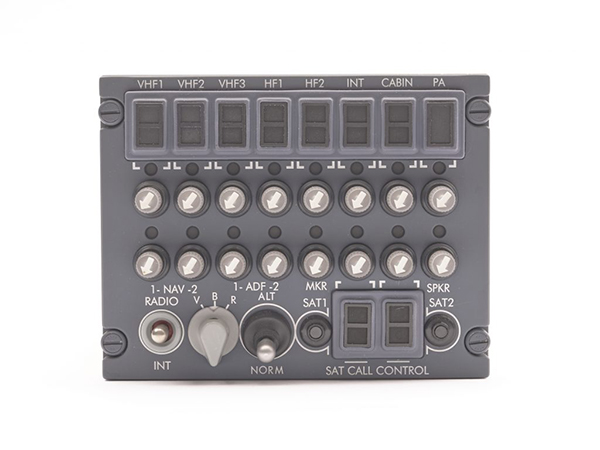Flight Deck Audio

Flight Deck Audio
Analog Systems
With origins extending back to the first aircraft of the Jet Age, AvtechTyee Analog Flight Deck Audio Systems are designed for simple mixing of navigation and communications audio in a compact form. Panel mount Audio Selector Panels (ASPs) integrate each received audio channel per the pilot input, and provide the headphone and microphone inputs and outputs for a pilot station. Today, AvtechTyee analog flight deck audio systems are in use on several Business Jet platforms, the Boeing 757 and 767 aircraft, and various special missions’ aircraft. There are five families of parts in the Analog Flight Deck category ranging from Series 5031, 5032, 5045, and 5650.
Multiplexed Control Systems
Starting in the late 1980s, AvtechTyee developed the innovative digital control architecture commonly used today in commercial aviation. The Audio Control Panel (ACP) now serves exclusively as a “mixing” panel for the pilots, with all analog audio input and output being managed in a Remote Electronics Unit (REU). This architecture reduces wiring between the cockpit and avionics bays, and centralizes the gain calibration and logic controls for the system in the avionics bay closer to the navigation and communications radios. The Digital Control Flight Deck Audio System was first deployed on the Dash 8 100/300 Series aircraft from DeHavilland, and followed in the CASA C235. It then was deployed on the Boeing 737 Classics, and carries forward today on the Boeing 737NG and 737MAX series aircraft. Digital Control Systems have also been adapted to special missions aircraft and trainers, with multiple ACP stations equipped to duplicate the flight deck interfaces for trainees and mission operators.
Digital Signal Processing Systems
With the advent of greater signal processing capabilities in the digital domain, AvtechTyee developed Audio Management Units (AMUs) that incorporate digital signal processors (DSPs) to reduce the analog circuitry associated with past audio system designs. In the DSP design, analog audio is encoded to digital by an Analog to Digital Convertor (ADC), and then processed in real-time by the DSP. When all mixed and filtered digital audio is ready for transmission, either to the flight crew headphones, or a radio transceiver, it is converted using a Digital to Analog Convertor (DAC). This round trip from analog to digital and back again is executed within microseconds, ensuring perfect audio performance. The more digital architecture coincided with additional aircraft management and computing capabilities, and the growth of Built In Test Equipment (BITE) philosophies in avionics. AvtechTyee DSP audio systems included dedicated Interactive, Power-up, and Continuous BITE software and hardware. AvtechTyee’s primary offering in this technology is the 5700 series Audio Management Unit (AMU), which is standard equipment aboard the Boeing 777 and 767-400 aircraft. The system is fully digital and paired with the 5701 Audio Control Panel and communicates via an ARINC 429 data bus. The 5701 series Audio Control Panel is also standard equipment aboard the 777 and 767-400 aircraft and features a full liquid seal which eliminates the harmful effects of coffee spills. All lighting is accomplished via LEDs
Voice over Internet Protocol (VoIP) Systems
Further advances in computing hardware and network technologies led to the aviation world’s first digital audio transmission system, used on the advanced Boeing 787 aircraft. This advanced system sought to reduce weight across the entire aircraft through the use of digital networks and distributed processing units. The centralized Audio Management Unit or Remote Electronic Unit has been replaced by the shared network resource of the aircraft, with network edge Audio Gateway Units (AGUs) and Audio Control Panels (ACPs)